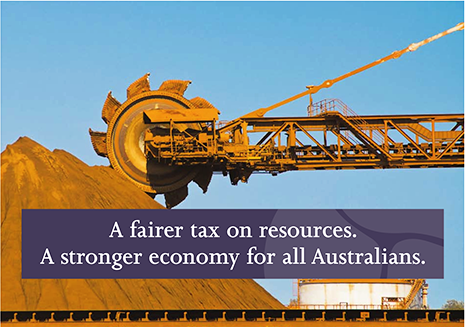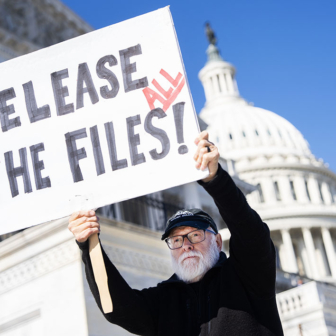CHANGE, fairness and economic strength: these are the central themes of the Rudd government’s new information campaign defending the “resources super profit tax.” The campaign aims to re-establish Labor’s credibility as a sensible, principled and reform-oriented government, developing and introducing policies of national significance. But the paradox for the government is that the advertising blitz itself risks muddying that message. Every time the ads appear, every time they’re mentioned by the opposition or critiqued in a newspaper column, the political motivation will dominate the message. The existence of the ads will act as a reminder that the government is willing to set aside both guidelines and principles.
So why has the government decided to open itself up to this attack, spending $38 million on a public information campaign that was destined to be controversial? Beyond the focus on the process, cost and timing, how effective are the advertisements, and are they worth the risk?
The Tax Plan for Our Future campaign consists of three radio and three newspaper advertisements (phase one) and two television advertisements (phase two). The ads are ostensibly designed to inform and reassure, to explain proposed taxation changes to Australian voters. Media criticism of the ads has centred on the government’s decision to exempt itself from its own approval guidelines, implemented in March of this year. The campaign has been described as cynical and hypocritical, and with the 2010 election looming the Coalition’s response will almost write itself, kicking off with a quote from the prime minister’s now infamous remark, in October 2007, that government advertising is “a sick cancer” in Australian democracy.
But the most remarkable thing about the ads themselves is that they are entirely unremarkable. They fade next to the striking green Strengthening Medicare ads from 2004 or the vibrant yellow of the WorkChoices campaign in 2007, two of the more controversial campaigns of the Howard era. Both were criticised for their election-year timing and their cost ($60 million for Medicare; $121 million for WorkChoices); but despite their controversial nature, the Howard government’s advertisements were memorable and persuasive. Who could forget the vivid imagery of the $100 million Unchain My Heart campaign in 2000, featuring Australians being unburdened of the chains of an unfair tax system (and given the GST in return)?
Effective political advertising is sharp; it communicates a clear message and relies on familiar imagery and memorable slogans. Conventional government advertising, by contrast, needs to educate people about the detail of a program or policy in order to be a valid “public information campaign.”
In many ways, the Rudd government is in a no-win situation when it comes to the current advertisements. They are uninspiring – too long-winded to attract the attention of most newspaper readers and too bland to catch the eye of viewers. If they were glossier, shinier, they would perhaps be more memorable; but they would also be more open to complaints that they’re little more than ads for the government’s re-election.
Government advertising cannot help but function as a promotion for the incumbent. No matter how bland in tone and style, they remind us that the government is active and engaged. Whether it’s asking us to Help Protect Australia from Terrorism from 2004 onwards or to Think Climate, Think Change in 2009, or trumpeting that Better Health and Better Hospitals were on the way earlier this year, government advertising speaks of reform, of change and progress.
The current newspaper ads are dense and packed with numbers. They tell us that if these reforms are passed then the company tax rate will be cut from “30 per cent to 28 per cent” and a “$700 million per year infrastructure fund” will be set up. These facts and figures are a kind of security blanket, giving the impression of a government that has done its homework, and reinforcing the complicated nature of not only the Henry Tax Review but also Labor’s response. They also help to guard against the criticism that the ads’ motivation is political.
The television ads are similar. They place the viewer in a lecture theatre, listening to a speech on the virtues of the taxation reforms. The presenter flicks through a PowerPoint presentation, with keywords, symbols, numbers, graphs, arrows and images of open-cut mining. There is no slick slogan, no background music and very little colour; even the audience looks disengaged.
But the ads are nevertheless designed to convey a powerful moral message. They tell Australians the proportion of profits from mining they currently receive – “$1 in every $7” – and point out that it has fallen from “$1 in every $3.” They attempt to garner support for the government by creating a clear sense of “us” and “them.” To draw voters together, they talk about the nation’s natural resources as belonging “to all of us.” By lamenting that “our share” of profits has been falling, they aim to establish not just a shared community but also a feeling of ownership and entitlement. Who could oppose “a stronger economy for all Australians” or a reform that will benefit “future generations” for decades to come? Who could oppose a tax that implements “fairness”? Even the name of the proposed tax is illustrative: this is not just a tax on the day-to-day profits of the mining industry, it is a tax on “super profits” so beyond the norm that they are unfair to ordinary Australians.
The identity of “them,” the people whose “super” share of profits has risen as “our” share has fallen, is more vague. The ads avoid pointing the finger directly at the mining industry; that task is left to the prime minister himself, filling in the blanks in his other media appearances.
The stage was set well before the ads appeared. On 3 May, a month before the ad campaign was launched, the prime minister reminded Lyndal Curtis on ABC Radio’s AM that BHP is 40 per cent foreign owned and Rio Tinto 70 per cent foreign owned, and as a result their “massively increased profits”, which are “built on Australian resources” are “mostly in fact going overseas.” In the interviews, media conferences and doorstops across the month that followed, Rudd was sharply on message, repeating over and over that these were resources that “ultimately belong to the Australian people” who deserve “their fair share.”
The prime minister is making strong claims about the unfair nature of the current system, tapping into long-standing Australian fears of foreign ownership. His language, combined with that of Treasurer Wayne Swan, creates the context for public debate. In this sense, the public information campaign ads serve as a placeholder rather than a centrepiece.
Ultimately, the content of these advertisements, dense and wordy as they may be, is not what is most important to the government. What matters most is the very fact of their existence. In the wake of the housing insulation controversy, the abandoned emissions trading scheme and the changes to the processing of asylum claims, a dangerous perception has emerged that Labor’s commitment to the issues on which it passionately fought the 2007 election has given way to short-term political expediency. The Rudd team desperately needs to be seen to stand up, to take up the fight on an issue of national importance.
The link between any particular piece of political communication and voting choices is notoriously difficult to measure. Voters make decisions based on a network of influences, including family and friends, education, the media, and the words and actions of politicians. Aside from the basic attempt to invoke a sense of community, there is little to arouse the passions of voters here. The resource super-tax advertisements are clean, dull and ultimately uninspiring.
The campaign exists to give Labor a voice in the debate – to remind voters that there are two sides to the argument, and to underline the mining industry’s vested interest in preventing the reforms from being implemented. And, most of all, it exists to emphasise that the prime minister will not back down over these proposed changes.
The ads’ true purpose is to provide a platform for the prime minister, a reminder of “Kevin07,” who seemed to speak clearly and passionately to the Australian people about his vision for the future. The ads aim to shift what is becoming an entrenched framework through which the media and political commentators view Rudd and his government: spin ahead of substance, big plans and little follow-through. They attempt to dispel the notion that this is a politically expedient government, willing to compromise previous passions when the electoral context demands. •




